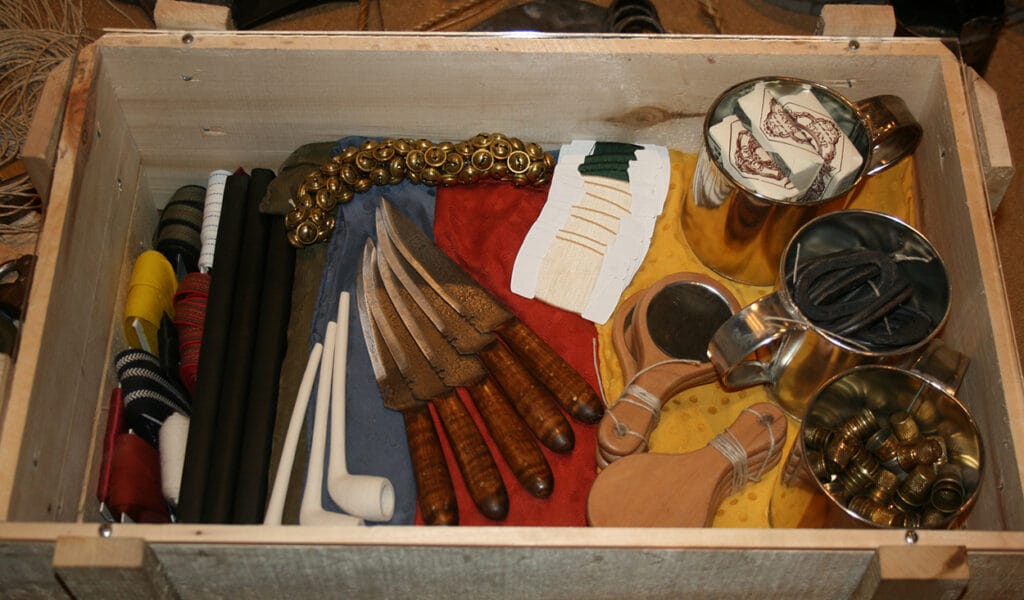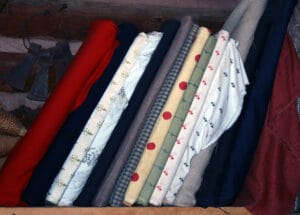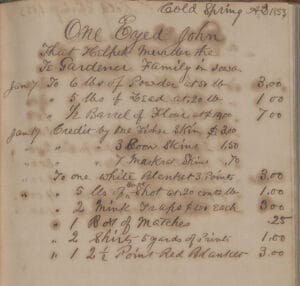
Crates of trade goods contained metal tools, pipes,decorative items, fabrics and more.
The fur trade was the lifeblood of the North American economy in the 17th and 18th centuries. What did Indigenous communities, particularly the Ojibwe, want in exchange for their highly prized beaver pelts? What’s your guess?
- Guns (the high-ticket item) and ammunition
- Metal tools (axes, knives, chisels, cooking kettles)
- Alcohol, or tobacco
- Blankets
- Beads, silver and decorative items
- Cloth and clothing
The answer might surprise you.
While metal tools (15-20%), weapons (10-15%) and beads and decorative items (>5%) played a role, one trade good dominated them all: cloth — at 60% of items traded.
The power of cloth: The #1 trade good

Fabrics seen at the Snake River Fur Post near Pine City, a Minnesota Historical Society site. The entire trading counter is pictured above.
Cloth wasn’t just fabric — it was currency. French and British traders found that Ojibwe and other Indigenous nations highly valued textiles, often trading furs at higher rates for woolen and cotton goods than for tools or even firearms. Why?
- Versatile: Cloth could be fashioned into clothing, blankets or decorative elements for regalia.
- Durable: Woolen fabrics like broadcloth and stroud cloth provided warmth and lasted for years.
- Culturally significant : The vibrant reds, blues and greens of trade cloth became woven into Indigenous traditions, ceremonies and everyday wear.
Which cloths were most popular?
Not all textiles were created equal in the fur trade. Here’s a look at the most sought-after fabrics:
- Woolen broadcloth: A dense, warm fabric used for coats and leggings. It was regularly noted in Hudson’s Bay Company trade ledgers, with shipments arriving from Britain to be distributed at major trading posts.
 Stroud cloth: A coarse wool, usually dyed red or blue, essential for winter wear and ceremonies. Alexander Henry the Elder mentioned that red stroud cloth was one of the most requested items by Indigenous traders.
Stroud cloth: A coarse wool, usually dyed red or blue, essential for winter wear and ceremonies. Alexander Henry the Elder mentioned that red stroud cloth was one of the most requested items by Indigenous traders.- Calico: A lightweight, printed cotton fabricloved for its patterns. The North West Company frequently listed calico in its trade accounts, with floral patterns being particularly popular.
- Linen: A strong, breathable fabric often used for shirts and undergarments.
- Point blankets: Thick wool blankets with now-iconic stripe patterns of Hudson’s Bay were sometimes tailored into coats (capotes).
- Cloth wasn’t just yard goods. Winnebago Indians who traded with A.C. Riggs in 1852-53 chose blankets and also leggins, broadcloth skirts, shirts and coats.
Besides economics, the fur trade was a cross-cultural exchange that reshaped Indigenous and European societies. Cloth became more than a commodity — it became part of Ojibwe identity, influencing dress, trade alliances and even ceremonies.
How do we know?

This entry from A.C. Riggs’ ledger of 1852-53 shows that the last two items One Eyed John traded for were 2 calico shirts (5 yards fabric) for $1 and a point blanket for $3.
Historical trade records give us a glimpse into these exchanges:
- Hudson’s Bay Company and North West Company ledgers document trade inventory. They also did post inventories (Hudson’s Bay Company Archives)
- Pemmican contracts and supply lists from fur trade posts confirm the items in highest demand.
- Voyageur and trader journals from the late 1700s (like Alexander Henry — both the Elder and the Younger — and Samuel Hearne) describe what goods were most desired by the Ojibwe and Cree. (Canadian Encyclopedia)
- “Making the Voyageur World” by Carolyn Podruchny and “The Fur Trade in Canada” by Harold Innis analyze trade economics and social exchange. “North American Indian Trade Goods 1670-1830″ by Charles Hanson lists the commonly traded items and how important they were.
The next time you picture the fur trade, don’t just think of beaver pelts and voyageurs — imagine bolts of bright red stroud cloth unfurling at a trade post, exchanged for furs that would one day become fashionable hats in Paris and London.
Sources:
- “Making the Voyageur World” by Carolyn Podruchny
- “The Fur Trade in Canada” by Harold Innis
- Hudson’s Bay Company Archives
- Canadian Museum of History – Fur Trade
Final Thoughts
- Read more about trade goods in my series of novels. Start from the beginning with Books 1 and 2 — buy “Waters Like the Sky” or “Treacherous Waters” through PayPal. Or the ebook. Book 3, “Uncharted Waters” is launched, in paper and ebook.
- Subscribe to this blog and read posts as they are published!
- For what I’m researching or quirky discovers, visit me on Facebook or Instagram: I love your comments.
- Book me as a speaker.
- Ask your library, local school, gift shop to buy copies.
- Become a voyageur for an hour — come to one of my presentations. Next up: “Women of the Fur Trade” 3 p.m., Thursday, April 3, at Whitney Senior Center in St. Cloud, Minnesota.




Thanks for the interesting items about the fur trading period
Who knew that that era, 200+ years ago, would be so fascinating to research. I’m glad you’ve enjoyed it. Thanks for the compliment!